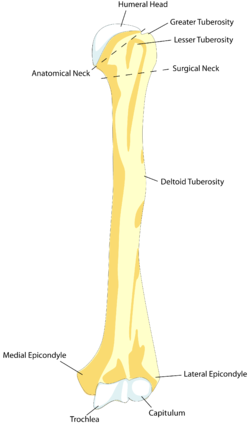Capitulum_of_the_humerus
Capitulum of the humerus
Structure of humerus
In human anatomy of the arm, the capitulum of the humerus is a smooth, rounded eminence on the lateral portion of the distal articular surface of the humerus. It articulates with the cup-shaped depression on the head of the radius, and is limited to the front and lower part of the bone.
This article includes a list of general references, but it lacks sufficient corresponding inline citations. (December 2013) |
In non-human tetrapods, the name capitellum is generally used, with "capitulum" limited to the anteroventral articular facet of the rib (in archosauromorphs).

